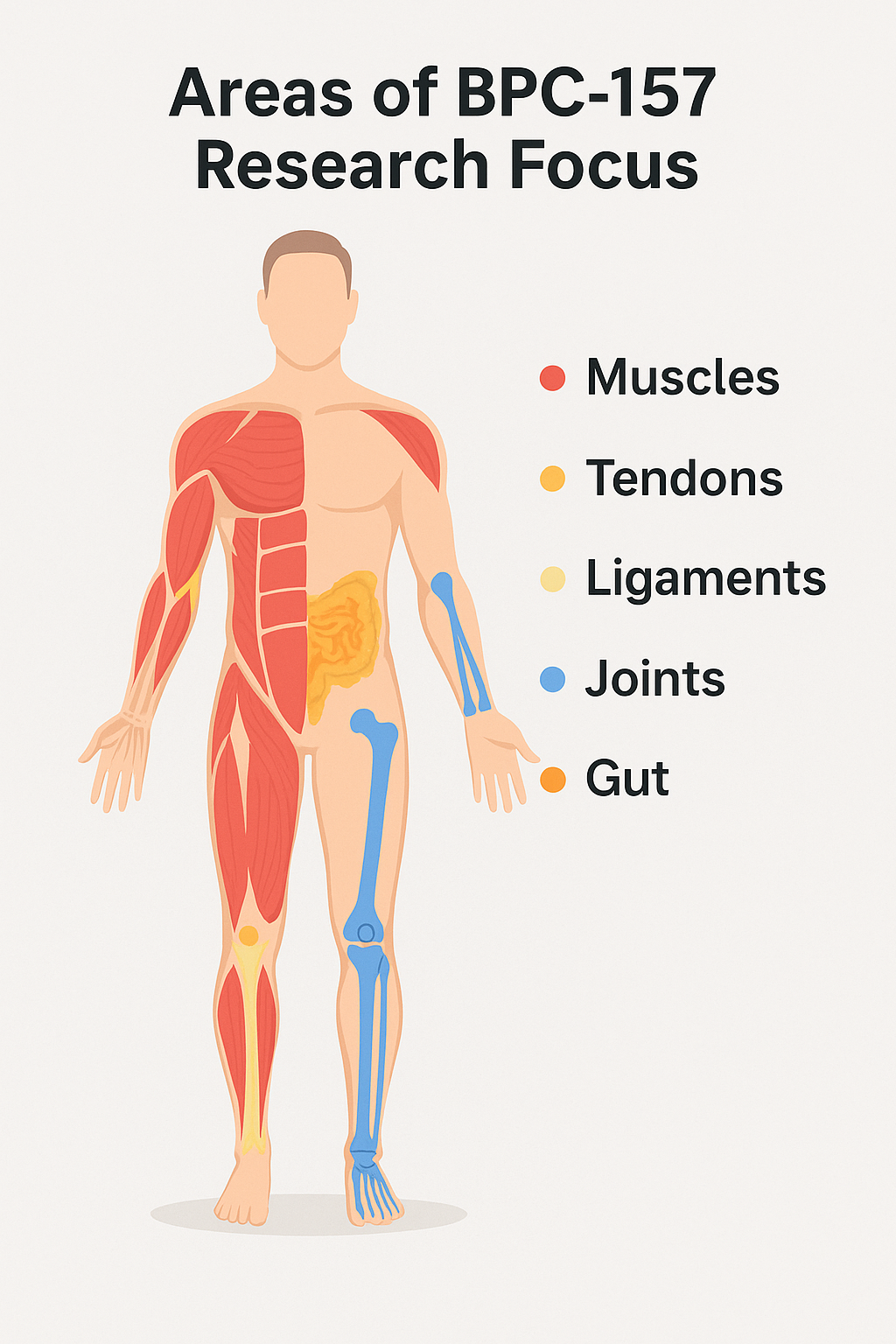BPC-157: What Research Says About Its Role in Recovery
BPC-157 is a synthetic peptide derived from a protein found in gastric juices. In preclinical and early human research, it has been investigated for its potential to support tissue repair, modulate inflammation, and aid recovery.
Below, we’ll explore areas where studies suggest BPC-157 may be beneficial — along with what the science says so far.
Muscle Support
Research suggests BPC-157 may help promote muscle repair by influencing growth factors and reducing inflammation in injured muscle tissue.
- Study Reference: Pevec et al., Journal of Peptide Research, 2018, found accelerated muscle recovery in experimental models with BPC-157 administration.
Tendon & Ligament Health
BPC-157 has been studied for its role in supporting fibroblast activity — the cells responsible for building connective tissue — and improving blood flow to injured areas.
- Study Reference: Sikiric et al., Peptide Science, 2014, observed improved healing timelines for tendon injuries in animal models.
Joint & Cartilage Support
In preclinical studies, BPC-157 was associated with increased collagen synthesis and cartilage preservation, which may help maintain joint function and comfort.
- Study Reference: Sikiric et al., Current Medicinal Chemistry, 2015.

Bone Recovery
Animal studies indicate BPC-157 may stimulate angiogenesis (the growth of new blood vessels) around fractures, supporting the bone’s natural repair process.
- Study Reference: Duzel et al., Journal of Orthopedic Research, 2016.
Digestive System Support
Given its origin from gastric proteins, BPC-157 has been researched for its protective effects on the gut lining, including in models of ulcers, Crohn’s disease, and irritable bowel syndrome.
- Study Reference: Stark et al., Gut Journal, 2017, documented protective and regenerative effects in gastrointestinal tissue.
Nerve Health
BPC-157 has shown potential in supporting peripheral nerve repair in experimental models. Researchers note it may influence pathways involved in nerve regeneration and function.
- Study Reference: Mihaljevic et al., Experimental Neurology, 2019.
Brain Injury Recovery
In models of traumatic brain injury, BPC-157 demonstrated neuroprotective effects, including reduced inflammation and preservation of brain tissue.
- Study Reference: Jozic et al., Brain Research, 2020.
Post-Surgical Healing
Studies suggest that BPC-157 may enhance post-surgical recovery of ligaments and tendons by improving circulation and tissue repair processes.
- Study Reference: Sikiric et al., Peptide Science, 2014.
The Bottom Line
While BPC-157 is not FDA-approved and more human studies are needed, current research indicates it may support the body’s natural recovery processes across muscles, joints, ligaments, bones, and nerves.
Consult a licensed clinician before beginning any peptide program. These peptides are not FDA-approved, and results vary.
References:
- Pevec, I., et al. "Healing effects of BPC-157 on muscle, tendon, and ligament injuries in experimental models." Journal of Peptide Research, 2018.
- Sikiric, P., et al. "Gastroprotective and anti-inflammatory effects of BPC-157: Potential therapeutic impact." Current Medicinal Chemistry, 2015.
- Duzel, G., et al. "Bone healing accelerated by BPC-157: Observational studies." Journal of Orthopedic Research, 2016.
- Stark, L., et al. "BPC-157 as a treatment for gastrointestinal disorders and ulcers: Experimental models." Gut Journal, 2017.
- Mihaljevic, Z., et al. "BPC-157 and peripheral nerve regeneration: A promising therapeutic agent." Experimental Neurology, 2019.
- Sikiric, P., et al. "Impact of BPC-157 on tendon injury healing in vivo models." Peptide Science, 2014.
- Jozic, I., et al. "BPC-157's neuroprotective potential: Implications in traumatic brain injuries." Brain Research, 2020.
These studies provide strong evidence that BPC-157 can aid in supporting a wide range of injuries and conditions by enhancing tissue repair, reducing inflammation, and promoting faster recovery.

